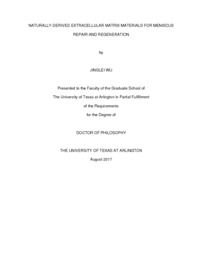
ATTENTION: The works hosted here are being migrated to a new repository that will consolidate resources, improve discoverability, and better show UTA's research impact on the global community. We will update authors as the migration progresses. Please see MavMatrix for more information.
Show simple item record
| dc.contributor.advisor | Hong, Yi | |
| dc.creator | Wu, Jinglei | |
| dc.date.accessioned | 2023-09-08T18:04:58Z | |
| dc.date.available | 2023-09-08T18:04:58Z | |
| dc.date.created | 2017-08 | |
| dc.date.submitted | August 2017 | |
| dc.identifier.uri | http://hdl.handle.net/10106/31637 | |
| dc.description.abstract | Human meniscus plays critical roles in a knee joint by transmitting weight-bearing force, absorbing shock, and stabilizing the knee joint capsule. Meniscal injuries are mainly caused by sports-related activities and age-related degeneration, which significantly reduce the life quality of patients. The injured meniscus has a very limited self-healing capability due to its poorly vascularized nature, specifically in the inner area. Surgical interventions are required to treat the injured meniscus, but the current treatments are not satisfactory because the post-surgery complications are frequently observed. Therefore, tissue regeneration approaches are developed to repair and functionally restore injured menisci. In this thesis, we focus on the development of extracellular matrix (ECM) based materials derived from porcine knee meniscus and investigate their potential in meniscus repair and regeneration.
We firstly decellularized porcine menisci based on a sodium dodecyl sulfate (SDS) protocol, processed the decellularized meniscus ECM into an injectable hydrogel, and then assessed the potential of the ECM hydrogel for meniscal repair and regeneration. The SDS treatment was effective in DNA removal and resulted in enriched collagen content and an obvious loss in glycosaminoglycan (GAG) content. The meniscus ECM hydrogel had a fibrous structure, tunable mechanical properties, and excellent injectability. It supported cell infiltration and three-dimensional (3D) cell growth in vitro. The solubilized meniscus ECM was capable of smoothly injecting into mice and showed good biocompatibility.
Secondly, in order to improve the GAG retention after decellularization, we optimized the meniscus decellularization protocol by comparing three chemical detergents and evaluated the differences among the resulting meniscus ECM hydrogels in material properties and biological performance. It was found that the peracetic acid (PAA) was the most effective in meniscus decellularization. It showed better preservation of ECM structure, maximal DNA removal, and the greater GAG retention compared with the SDS and Triton X-100 (TX) treatments. The PAA-treated ECM (PAA-ECM) hydrogel possessed greatest compressive strength. It promoted significantly higher GAG accumulation of fibrochondrocytes and exhibited the highest biomechanical strength when encapsulated with fibrochondrocytes and cultured for 28 days.
Subsequently, we sought to prepare regionally-specific meniscal ECMs by dividing porcine menisci into three distinctive zones and decellularizing them with the optimized protocol. The inner meniscus ECM contained less collagen and significantly higher GAG compared with the middle and outer meniscus ECMs. These biochemical variations resulted in the varying compressive strengths of the regional ECM hydrogels and greatly influenced the cell behaviors in the hydrogels. Specifically, when encapsulated with bovine fibrochondrocytes for 28 days, the inner meniscal ECM hydrogel accumulated more GAG, contracted to a greater extent and exhibited higher compressive strength compared with that of the outer meniscal ECM hydrogel.
Based on the above three aims, our future study will focus on illustrating the versatility of meniscus ECM in biomedical applications. Preliminary results demonstrated that decellularized meniscus ECM can be blended with polycaprolactone (PCL) and electrospun to form PCL/ECM hybrid nanofibrous scaffolds. The PCL/ECM scaffolds had better hydrophilicity, greater tensile strengths, and initial moduli compared to the PCL scaffold alone. The PCL/ECM scaffold was cytocompatible to support meniscus fibrochondrocyte growth and was capable of promoting GAG accumulation, indicating its great potential for meniscus repair and regeneration.
In summary, this work demonstrates the development and optimization of decellularized meniscal ECMs. It provides a platform for the preparation of injectable meniscal ECM hydrogels that exhibit meniscal tissue-specific bioactivity and support 3D meniscal cell growth and promote cell-secreted products, which may have opportunities to treat injured menisci through a minimally-invasive manner. | |
| dc.format.mimetype | application/pdf | |
| dc.language.iso | en_US | |
| dc.subject | Meniscus | |
| dc.subject | Decellularization | |
| dc.subject | Extracellular Matrix | |
| dc.subject | Fibrochondrocyte | |
| dc.subject | Tissue Engineering | |
| dc.title | NATURALLY-DERIVED EXTRACELLULAR MATRIX MATERIALS FOR MENISCUS REPAIR AND REGENERATION | |
| dc.type | Thesis | |
| dc.date.updated | 2023-09-08T18:04:58Z | |
| thesis.degree.department | Bioengineering | |
| thesis.degree.grantor | The University of Texas at Arlington | |
| thesis.degree.level | Doctoral | |
| thesis.degree.name | Doctor of Philosophy in Biomedical Engineering | |
| dc.type.material | text | |
| dc.creator.orcid | 0000-0001-9549-3992 | |
Files in this item
- Name:
- WU-DISSERTATION-2017.pdf
- Size:
- 4.923Mb
- Format:
- PDF
This item appears in the following Collection(s)
Show simple item record


